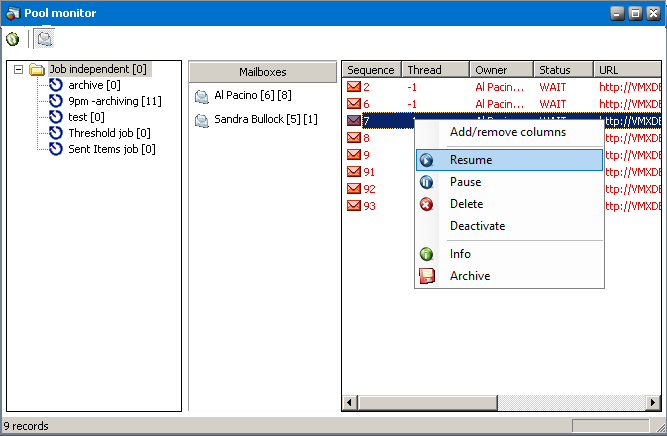Steps to start a job running immediately:
1.Go to the Jobs tab in Manager view.
2.Select the job either stopped or a scheduled one. Right-click it and in the context menu select Start now! The respective job will start running immediately.
|
|
NOTE: Jobs which are just running are highlighted in green in the Existing jobs pane of the Jobs tab. |
Steps to stop a scheduled job:
1.Go to the Jobs tab in the Manager view.
2.Select the scheduled job. Right-click it and in the context menu select Stop. The respective job will stop running and its status will be changed to Stopped (displayed red)
|
|
NOTE: You always must stop a job if you want to change its settings. Settings of a scheduled or running job cannot be changed. |
On the figure below you can see the Group tab of the Manager view. List in the left pane displays groups of users synchronized with Archive Manager. Some group icons are displayed in green, the others not. Green indicates that the group has been activated for archiving.
When you select a group on the Groups tab its properties are subsequently displayed in the right pane.
The right pane is useful as there you can see some of the groups properties. For example on the previous figure you can see that SEA Pilote is activated for archiving (Activated: Yes), scheduling will be done with 9pm-archiving (Scheduled in job: 9pm-archiving), Outbox and Deleted items folders are excluded from automated archiving (Exclude folders: Outbox, Deleted items), all files bigger than 10.24 MB will be archived (Archive files bigger than: 10.24 MB), message classes that will be archived include IPM.Note, IPM.Post, IPM.Document (Included message classes: IPM.Note, IPM.Post, IPM.Document).
|
|
NOTE: For more information on group settings see the section "Setting criteria for group archiving. |
To archive emails of a group with a job:
1.In Manager view click on the Groups tab.
2.Right-click a group and, in its context menu, click Properties to open its Properties window.
3.On the General tab check if that group has been activated for archiving (the Allow to archive checkbox must be selected). Then click Apply.
4.On the Scheduler tab select the job in the Selected job dropdown menu. Click Apply and OK to confirm all.
Job reporting is a feature which allows the administrator to see how many messages are waiting (are scheduled) for archiving, i.e. how many messages were given to the asynchronous archiving service (DirectArchive service).
The messages are collected from different sources: scheduled jobs. When a "source decides to archive messages, it simply puts them into a database table. The asynchronous service periodically reads this table and processes messages, depending on job settings.
The job reporting feature simply displays the content of that database table: it displays ONLY those messages that are queued for processing. The content is automatically categorized by the start time of the job.
Steps to see the status or how many messages are queued for archiving:
1.In Manager view, click on the Jobs tab. All jobs you have defined so far are displayed in the left pane. At the bottom of that pane, click on the Job reporting tab to open the Pool monitor window.
2.In the Pool monitor window unfold the Job independent node. You will get displayed all your jobs. Number next to the job indicates how many emails assigned to the job are waiting to be processed. Under the Job independent folder you can find emails from DirectArchive which are waiting to be processed.
3.To get more details about the chosen job simply click on it. Items to be processed by that job appear in the right pane of the window. The number of items is displayed also at the bottom in the left corner. Click the Refresh icon to update the situation.
|
|
NOTE: A lot of useful information can be found in the list view, e.g. the sequence number of the item (Sequence), ID of the owner (Owner), Status (WAIT - waiting to be processed or PAUSED the respective job is stopped), location of the mailbox item (URL), the date of creation (Creation date), number of unsuccessful attempts to process the item (Error count), ID of the job in charge of the item (Job) etc. |
4.Click the View switcher icon (
Click on the mailbox node (in our example user004) to display the waiting items of that mailbox.
5.If archiving of an item failed even after several attempts, it is displayed red. In such cases you may try to archive it again. Right-click the item and select Resume in the context menu.

There are other options in the context menu for any item as well:
·Pause archiving of that item will be paused, i.e. will not be process in that cycle, however, it will be processed in the subsequent cycle.
·Deactivate - the respective item will never be processed by the job in question.
·Delete the item will be deleted from the list.
·Info Message information window opens displaying location, mailbox, subject, receive date, message class and size of the selected message
Select Add/Remove columns option to customize the order and selection of columns in the list view of the Pool monitor.